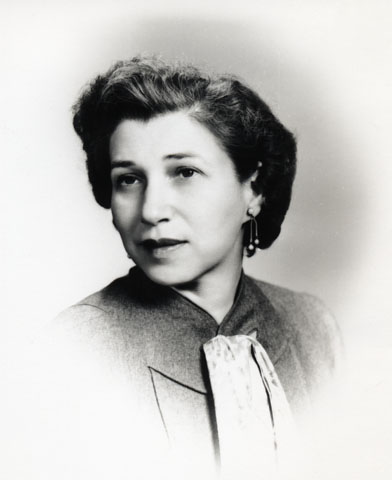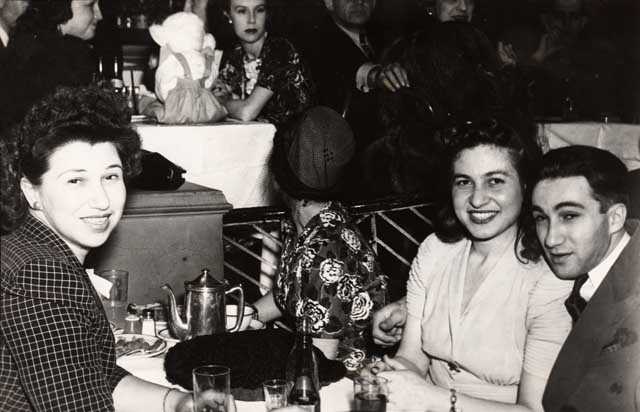An Observant Jewish Household

|
MAX HARRY GASS AND ADELE KORFF GASS: A LIFE TOGETHER An Observant Jewish Household |
|
Adele and Max both adhered to Jewish tradition. However, Max was more observant and practiced traditional rituals strictly. Adele, more modern in outlook, modified her observances in situations where she found the ritual no longer served its intended purpose. This form of reasoning led Adele to stop going to the mikva (the ritual bath). Adele explained:
“The week before my wedding I had gone to the mikva. According to the Bible, immersion in a mikva is required to restore an impure person to a state of purity. Women are considered to be unclean when they get their periods and they are supposed to abstain from relations with their husbands. On the seventh day after a woman's period has ended, she is suppose to go to the mikva and then she can resume her wifely obligation.
“After the wedding and up until my father passed away I went to the mikva regularly, and then I didn't go any more. Going to the mikva was time consuming. I spent about an hour within the mikva building itself and then I spent time traveling back and forth to it. I felt that you could get just as clean in a shower.
"The mikva was like a deep tub. According to Jewish Law, the water in it has to come from a natural source like a well, spring, or lake. Even water from rain or melted snow or ice can be used.
“At the mikva, there is a female attendant who trims your nails. Then you take a bath and clean yourself all over. A covering is draped over you and you walk down a few steps into the mikva. The attendant takes the covering because you are supposed to enter the water without anything on. Next, you dunk once and the attendant says a special immersion blessing. Then you dunk twice more and come out.
“There was a fee. I tipped more because I didn't want to immerse myself in anybody else's water. Because the water wasn't very clean in the Chelsea mikva, I paid the attendant to drain the mikva and scrub the sides before refilling it for me.
“I went to the mikva while my father was alive because when I missed a month meddlers always informed him and I didn't want to hurt him.”
|
|
 |
|
Portraits of Adele |
Daily Prayer and Food Blessings
Daily observance was a given in the Gass home. Before eating breakfast, Max always said the morning prayers, reciting them at home unless it was a holiday, the Sabbath, or a day that he didn’t go into work. On those days he went to shul [the synagogue]. He began with the Modeh Ani, the first prayer of the day, where he thanked G-d for restoring him to consciousness after his night's sleep. On weekdays he wore tefillin[1] on the arm and head during the morning service. (Tefillin aren't worn on Shabbos or on holidays.)
Max practiced ritual hand washing in the morning before he laid his tefillin and davoned (prayed). He filled a special two-handled cup with water and transferred it from his right hand to his left. Then he poured some water on his right hand, transferred the cup back to his right hand, and poured water on his left hand. He repeated these steps twice more and then recited the hand-washing blessing. He also performed this ritual before each meal.
Following Jewish custom, Max always recited a blessing for everything he ate, even snacks. At the beginning of meals where bread was served, he would sprinkle the bread with salt[2] and say the Ha-motzi blessing:
Baruch ata Adonoi Elohenu melech ha-olam, ha-motzi lechem min ha-aretz.
(Praised be Thou, O Lord our God, King of the universe, who brings bread from the earth.)
The Ha-motzi prayer covers all the foods that are eaten during the meal. However if bread is not included then a special blessing for each kind of food is recited. There is a special blessing for vegetables, for fruits, for wine, for beverages other than wine, and a catch-all blessing thanking G-d for creating many types of foods.
Max always bentched (sang grace) after meals. If there were at least three men present—a mezuman (quorum needed)—he began the grace with a special introduction.
Max loved to tell stories, especially ones from the Bible. He would begin with a tale that seemed contemporary in nature but then he would slip in a story from the Bible. He was a master of puns and would try to trick the children into learning about being a Jew.
|
|
|
Janet Gass |
Max davoned every night and then he would say the Shema. This was the first blessing he and Adele taught their children and they said it when they were small before going to sleep but as they grew up they stopped saying it at bedtime.
|
|
|
Adele and Max occasionally made time for an evening out during the busy child-rearing years. Top photo: Adele and Max; bottom photo: Adele with her brother Nathan Korff and ?? |
 |
[1] Tefillin were created to carry out the commandment to place a sign upon the hand and forehead as a reminder to fulfill G-d's commandments. They are composed of two parts. The tefillin shel yad is wound around the arm and hand. The tefillin shel rosh is placed on the head. Each part has a bayit, a box, made from the skin of a kosher animal in the shape of a perfect square.
The shel yad has one compartment; the shel rosh has four separate compartments and has the Hebrew letter shin on two sides of it. In each box, written on parchment, is one set of four Torah portions dealing with the mitzvah of tefillin:
· 'And this shall serve you as a sign on your hand and as reminder on your forehead--in order that the teachings of the Lord may be in your mouth--that with a mighty hand the Lord freed you from Egypt.' (Exodus 13:9)
· 'And so it shall be as a sign upon your hand and as symbol on your forehead that with a mighty hand the Lord freed us from Egypt.' (Exodus: 13:16)
· 'Bind them as a sign on your hand and let them serve as a symbol on your forehead.' (Deuteronomy 6:8)
· 'Therefore impress these my words upon your very heart: bind them as a sign on your hand and let them serve as symbol on your forehead.' (Deuteronomy 11:18)
For the shel yad the portions are written on a single piece of parchment; for the yad rosh each portion is written on a separate parchment.
"The tefillin are placed on the arm and the forehead in a prescribed manner with the saying of prescribed blessings. One long strap knotted in the shape of the Hebrew letter yod is attached to the shel yad. This strap is shaped in the form of a noose so it can be tightened on the arm. Another long strap knotted in the shape of the Hebrew letter dalet is attached to the shel rosh. It forms a circle which can be adjusted to fit the head.
[2] The tradition of sprinkling salt on bread has it roots in ancient times when our forefathers salted all their sacrifices. According to the Talmud, "A man's table is like the altar," so traditional Jews salt their bread before eating it.